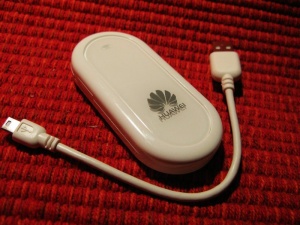CDMA2000
CDMA2000 (also known as IMT Multi‑Carrier (IMT‑MC)) is a family of 3G mobile technology standards, based on CDMA, to send voice, data, and signaling data between mobile phones and cell sites. The set of standards includes: CDMA2000 1X, CDMA2000 EV-DO Rev. 0, CDMA2000 EV-DO Rev. A, and CDMA2000 EV-DO Rev. B. All are approved radio interfaces for the ITU's IMT-2000. CDMA2000 has a relatively long technical history and is backward-compatible with its previous 2G iteration IS-95 (cdmaOne). In the United States, CDMA2000 is a registered trademark of the Telecommunications Industry Association (TIA-USA). The intended 4G successor to CDMA2000 was UMB (Ultra Mobile Broadband), however in November 2008, Qualcomm announced it was ending development of the technology, favoring LTE instead.
1X
CDMA2000 1X (IS-2000), also known as 1x and 1xRTT, is the core CDMA2000 wireless air interface standard. The designation "1x", meaning 1 times Radio Transmission Technology, indicates the same RF bandwidth as IS-95: a duplex pair of 1.25 MHz radio channels. 1xRTT almost doubles the capacity of IS-95 by adding 64 more traffic channels to the forward link, orthogonal to (in quadrature with) the original set of 64. The 1X standard supports packet data speeds of up to 153 kbps with real world data transmission averaging 60–100 kbps in most commercial applications. IMT-2000 also made changes to the data link layer for the greater use of data services, including medium and link access control protocols and QoS. The IS-95 data link layer only provided "best effort delivery" for data and circuit switched channel for voice (i.e., a voice frame once every 20 ms).
1xEV-DO
CDMA2000 1xEV-DO (Evolution-Data Optimized), often abbreviated as EV-DO or EV, is a telecommunications standard for the wireless transmission of data through radio signals, typically for broadband Internet access. It uses multiplexing techniques including code division multiple access (CDMA) as well as time division multiple access (TDMA) to maximize both individual user's throughput and the overall system throughput. It is standardized by 3rd Generation Partnership Project 2 (3GPP2) as part of the CDMA2000 family of standards and has been adopted by many mobile phone service providers around the world – particularly those previously employing CDMA networks. It is also used on the Globalstar satellite phone network.
Networks
The CDMA Development Group states that, as of November 2009, there are 308 operators in 116 countries offering CDMA2000 1X and 1xEV-DO service.
External links
- CDMA2000 Development Group (CDG)
- 3GPP2 Standards and specifications
- TIA Standards documentation
